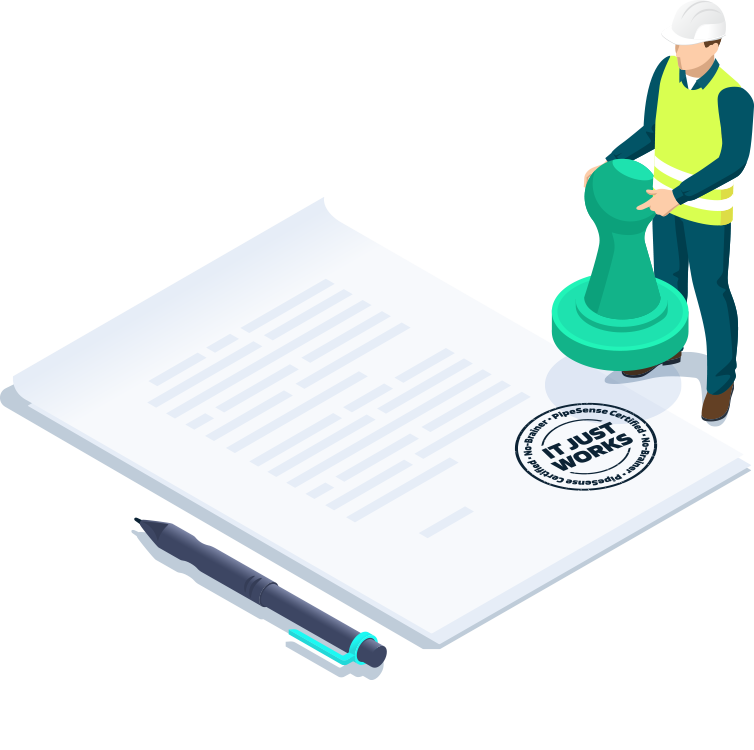Pass the pressure test: How AI accurately detects leaks from ultra-high frequency pressure sampling

PipeSense pipeline leak detection flags leaks within minutes, avoids false positives and pinpoints the source with location accuracy within 50 feet. It delivers certainty in situations where most systems relay noise. It’s common sense in a world of nonsense.
To operators beaten down by decades of uncertainty, it can feel like magic.
In reality, it’s the result of a tightly integrated system of physics, signal processing and machine learning engineered from the ground up to catch the earliest physical signal of a leak: the pressure pulse. While legacy leak detection systems issue alerts only after they register a flow imbalance or volumetric shortfall, PipeSense responds at the exact millisecond the pipe breaches and a pressure wave radiates through the product column. Then, our pipeline integrity software confirms whether the signal is a real leak event or routine fluctuations in real-time.
Here’s how it happens:
1. Capture the first clue (at 1,000 samples per second)
Every leak begins with a pressure event — a split-second wave that travels through the pipeline before any volume is lost and flow balance registers anything’s wrong.
PipeSense captures that moment at 1,000 samples per second. These signals, known as negative pressure waves, radiate outward from the leak site, moving upstream and downstream through the product column. They’re short, sharp and consistent. A kind of sonic fingerprint that tells us exactly when and where a breach occurred.
It’s important to note, pressure pulses alone are not indicative of an actual leak event. Compressor kicks, valve closures and pump startups generate similar transients. The problem is that most legacy pipeline leak detection systems can’t tell the difference. They don’t sample fast enough or filter smart enough to separate signal from static. Our pipeline integrity software flips the script.
How legacy leak detection systems are failing operators >
2. Timestamp and sync across the line
Pressure pulses from actual leak event don’t happen in just one place — its signature reverberates across the line. So, interpreting that signal and moving forward with confidence requires more than pressure data. You need timing.
Every PipeSense field processing unit (FPU) is GPS-synchronized. While each unit operates independently, sampling pressure locally at 1,000 kHz, they all share a common timing (accurate to the millisecond). What does this mean? Every pressure anomaly, no matter where it occurs, is recorded with a precise timestamp that’s consistent across the network.
Why does this matter? Because pressure pulses travel at a known velocity through the product medium, confirmed during system commissioning. When a leak occurs, the pulse propagates upstream and downstream at that speed. By comparing exactly when that wave reached each sensor, PipeSense pipeline integrity software can pinpoint the origin.
No fiber links. No peer-to-peer communications. Just physics, timing, and GPS accuracy. The result: leak location within 50 feet, without relying on flow models, SCADA alignment, or central controllers. Something legacy pipeline leak detection systems could never.
3. Isolate the event in real-time
Pressure spikes happen all the time in pipeline operations. Some matter. Most don’t. PipeSense was built to know the difference, and that judgment starts at the edge.
As soon as a pressure pulse crosses a detection threshold, the FPU immediately stores a high-resolution snapshot: one minute of data before the event, and one minute after. This creates a contextual window — not just a blip, but a full pressure timeline surrounding the anomaly. During this process, the FPU performs real-time signal filtering. It sharpens the edges of the pressure trace, reduces background chatter and flags events based on shape, duration, and deviation from local baseline behavior. It’s not calling anything a leak yet, but it’s preparing the dataset for deeper analysis.
This edge-based triage is critical. Legacy pipeline leak detection systems often rely on basic thresholds or rely on SCADA rules written for ideal conditions, resulting in either constant false positives or total desensitization. Our pipeline integrity software avoids both. To put it simply, it doesn’t fire on noise. It curates real signals for real evaluation.
4. Convert pressure into frequency
Pressure over time tells one part of the story. Frequency reveals the rest.
Once the event data package is transmitted to the central server (either on the client’s infrastructure or securely hosted by PipeSense) the event is transformed from the time domain into the frequency domain. This conversion generates a 3D frequency plot: a visual and analytical map of time, amplitude, and spectral energy.
What emerges is a pressure “fingerprint.” Leak events always show up with the same distinct features. Whether the line is carrying gas or liquid, whether the diameter is 6-inch or 36-inch, this frequency shape remains consistent.
In contrast, non-leak pressure events like valve chatter, compressor surges, and pump cycling appear different. To AI, the difference is unmistakable. Legacy pipeline leak detection systems never make it this far. They stop at thresholds. PipeSense keeps going — straight into the frequency spectrum where leaks reveal themselves.
5. Match the signature to a verified database
This is where interpretation becomes confirmation. Every frequency plot generated by PipeSense’s leak detection system is compared to a proprietary database of more than 35,000 verified pressure events — a catalog built from years of field data, simulated leak releases and operational anomalies. Each signature is tagged as either a leak or a known non-leak, based on real-world outcomes.
The AI at the core of our pipeline integrity software analyzes each event’s spectral shape, intensity, rise/fall characteristics, and duration. It then searches for a match in the library and ranks its confidence. If the signature aligns with a verified pipeline leak detection pattern and meets the confidence threshold, it’s confirmed. If not, it’s discarded.
This purpose-built AI model is specifically trained for pipeline pressure events. And unlike off-the-shelf AI, this model doesn’t drift. It’s continuously refined by PipeSense engineers who review edge cases, validate system decisions, and ensure that “smart” stays smart.
6. Issue a pinpoint alert in real-time
Once a leak is confirmed, PipeSense’s pipeline leak detection system moves fast.
An alert is issued instantly — complete with timestamp and GPS coordinates. The control room dashboard updates in real-time, showing the exact segment and location where the event occurred. Operators see the when, the where, and the what all at once.
There’s no decoding required. No cross-referencing with SCADA. No wondering if it’s a nuisance alert or something worth shutting down for. Because PipeSense doesn’t raise the flag unless the system is sure.
That level of clarity matters. It means dispatching crews with purpose, not on hunches. It means planning repairs before product loss snowballs. It means staying online until you have a reason to act — and then acting with confidence. In high-consequence environments, that kind of certainty is what defines truly effective pipeline leak detection.
Pressure pulse analysis and AI: Why it matters
By anchoring detection to the earliest physical event, the pressure pulse, PipeSense delivers clarity within minutes, not hours. It doesn’t wait for volume loss. It doesn’t require flow model adjustments. It doesn’t trigger at the threshold of disaster. It works upstream of the problem — physically and operationally.
Faster response, less loss
The earlier your pipeline leak detection system identifies a leak, the more you can save — in product, cleanup, downtime, and regulatory exposure. PipeSense cuts response time from hours to minutes, reducing the size and cost of an incident before it spreads.
Pinpoint location = no wild goose chases
When PipeSense issues an alert, it includes GPS coordinates within 50 feet of accuracy. That eliminates the “needle in a haystack” problem. No wasted hours walking the line. No exploratory digs. Just actionable intel from a smarter leak detection system.
Zero false positives = zero wasted effort
Every alert is real. That means no unnecessary shutdowns, no truck rolls for non-events, and no eroded confidence in your pipeline integrity software. Field teams know when to move and when to stay focused on scheduled work.
Proven clarity = audit confidence
Each confirmed leak is logged with a high-fidelity data record, complete with a timestamp/GPS coordinates. It’s not just leak detection — it’s forensic-grade documentation, ready for regulators or internal review.
One system, many use cases
The same AI, pressure sampling, and physics engine that powers pipeline leak detection also enables blockage detection, hydrotest monitoring and pre-existing leak validation. It’s not a niche tool. It’s a platform for modern pipeline integrity.
It’s not magic. It’s physics, engineering and a lot of math.
PipeSense doesn’t trade in black box promises. What makes the system work isn’t hidden. It’s built on transparent, proven methods: high-frequency sampling, GPS-synced time series data, spectral analysis and machine learning trained on real-world results.
That’s the real pressure test — and PipeSense passes it every time.

What does it take to be PipeSense Certified?
A LOT, and that’s by design. Explore what our quality seal means to us and, more importantly, what it means for you. (Hint: More free time, less frustration.)
